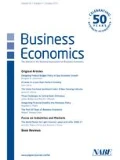Abstract
There is an increasing interest in the economic and financial knowledge of the public. Former Federal Reserve Chairmen Greenspan and Bernanke often stressed the importance of improved economic and financial knowledge of the general public. Recent survey results from the 2012 National Financial Capability Study provide a rich source of information on the state of financial capability of Americans. In this paper we examine the actual knowledge of individuals, investigate how they self-assess their financial capability and knowledge, and analyze the way these relate to financial outcomes. We also examine the way these measures relate to demographic variables. We find that there is room for improvement in financial knowledge, decisions, and capability, which varies among demographic groups and suggest measures for such improvement.
Similar content being viewed by others
Notes
The website for the CFPB is www.consumerfinance.gov.
The website containing the details about the survey is www.usfinancialcapability.org.
These data are now being used more extensively by researchers. Examples include Collins [2012] and Robb and Woodyard [2011].
As there are only five actual knowledge questions, scoring below 0.6 would imply a person only correctly answered one or two questions or possibly none correctly. Therefore, below 0.6 would only include the none correct, one correct, and two correct groups.
One group from each category must be left out of the regression to prevent the “dummy variable trap.” The left out group becomes the reference (or baseline) from which to compare the other groups.
The survey contains numerous possible outcome or decision measures. We selected a few as representative.
For the econometric purists, we note that we also estimated probit models for the models with binary dependent variables and the results were similar in terms of sign and significance of coefficients.
This report is available at www.councilforeconed.org.
References
Bernanke, Ben S. 2013. Financial and Economic Education. Speech at the 13th Annual Redefining Investment Strategy Education (RISE) Forum, Dayton, Ohio (via prerecorded video), April 4, http://www.federalreserve.gov/newsevents/speech/20130404a.htm.
Campbell, John Y. 2006. “Household Finance.” Journal of Finance, 61 (4): 1553–1604.
Campbell, John Y., Howell E. Jackson, Brigitte C. Madrian and Peter Tufano . 2011. “Consumer Financial Protection.” Journal of Economic Perspectives, 25 (1): 91–114.
Collins, J. Michael 2012. “Financial Advice: A Substitute for Financial Literacy?.” Financial Services Review, 21 (4): 307–322.
Fonseca, Raquel, Kathleen J. Mullen, Gema Zamarro and Julie Zissimopolous . 2012. “What Explains the Gender Gap in Financial Literacy? The Role of Household Decision Making.” Journal of Consumer Affairs, 46 (1): 90–106.
Garcia, Maria Jose Roa . 2013. “Financial Education and Behavioral Finance: New Insights into the Role of Information in Financial Decisions.” Journal of Economic Surveys, 27 (2): 297–315.
Greenspan, Alan . 2002. “Financial Literacy: A Tool for Economic Progress.” Futurist, 36 (4): 37–41.
Hamermesh, Daniel S. 2004. “Maximizing the Substance in the Soundbite: A Media Guide for Economists.” Journal of Economic Education, 35 (4): 370–382.
Hastings, Justine S., Brigitte C. Madrian and William L. Skimmyhorn . 2013. “Financial Literacy, Financial Education, and Economic Outcomes.” Annual Review of Economics, 5: 347–373.
Lusardi, Annamaria and Olivia S. Mitchell . 2007. “Financial Literacy and Retirement Preparedness: Evidence and Implications for Financial Education.” Business Economics, 42 (1): 35–44.
Lusardi, Annamaria and Olivia S. Mitchell . 2014. “The Economic Importance of Financial Literacy: Theory and Evidence.” Journal of Economic Literature, 52 (1): 5–44.
Morgan, James N. 1955. Consumer Economics. Prentice-Hall.
Olsen, Anya and Kevin Whitman . 2012. “An Overview of Contemporary Financial Education Initiatives Aimed at Minority Populations.” in Consumer Knowledge and Financial Decisions, edited by Douglas J. Lamdin. Springer, 77–100.
Rhine, Sherrie L.W. and William H. Greene . 2013. “Factors that Contribute to Becoming Unbanked.” Journal of Consumer Affairs, 47 (1): 27–45.
Robb, Cliff A. and Ann S. Woodyard . 2011. “Financial Education and Best Practice Behavior.” Journal of Financial Planning and Counseling, 21 (1): 60–70.
Schneider, Friedrich and Gebhard Kirchgassner . 2009. “Financial and World Economic Crisis: What Did Economists Contribute?” Public Choice, 140 (3/4): 319–327.
Schuchardt, Jane, Sherman D. Hanna, Tahira K. Hira, Angela C. Lyons, Lance Palmer and Jing Jian Xiao . 2009. “Financial Literacy and Education Research Priorities.” Journal of Financial Counseling and Planning, 20 (1): 84–95.
Willis, Lauren E . 2009. “Evidence and Ideology in Assessing the Effectiveness of Financial Literacy Education.” San Diego Law Review, 46 (2): 415–458.
Additional information
*Mark A. Johnson has been an assistant professor in the Sellinger School of Business and Management of Loyola University Maryland since 2010. He has also served as a visiting faculty member at Wake Forest University. His research interests include financial markets, behavioral finance, consumer sentiment, and investments. He holds a B.S. from Florida State University, M.S. degrees from Florida International University and the University of New Orleans, and a Ph.D. in Financial Economics from the University of New Orleans. Douglas J. Lamdin is Professor of Economics at the University of Maryland, Baltimore County. He has also been a visiting Professor of Finance at the R.H. Smith School of Business at the University of Maryland, College Park. His research interests are corporate finance, investment management, and consumer finance. He also serves on the Editorial Boards of Business Economics, Journal of Personal Finance, and Journal of Financial Counseling and Planning. He holds a B.A. from the University of Maryland, Baltimore County and an M.A. and a Ph.D. from the University of Maryland, College Park.
Rights and permissions
About this article
Cite this article
Johnson, M., Lamdin, D. Gauging the Financial Capability of Americans. Bus Econ 50, 135–146 (2015). https://doi.org/10.1057/be.2015.24
Published:
Issue Date:
DOI: https://doi.org/10.1057/be.2015.24




